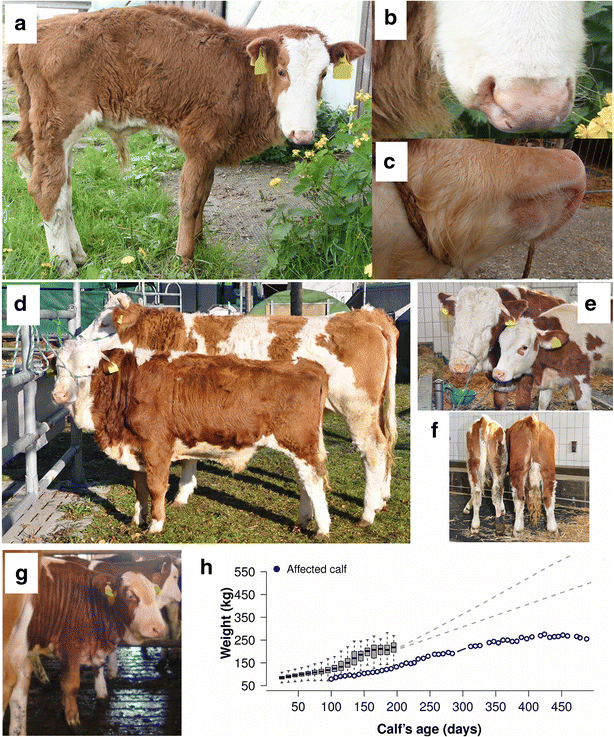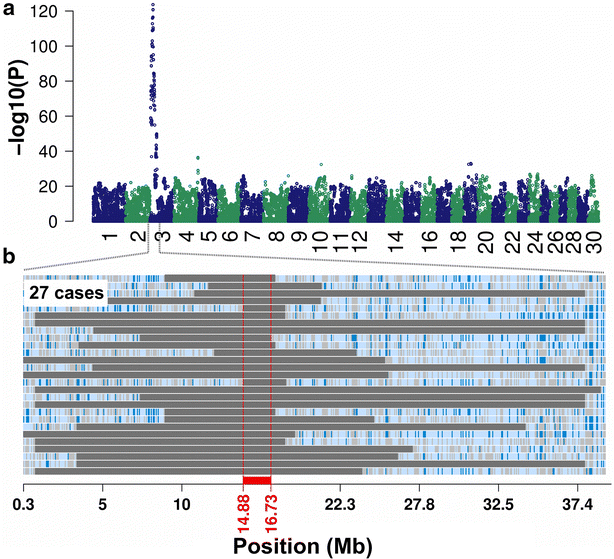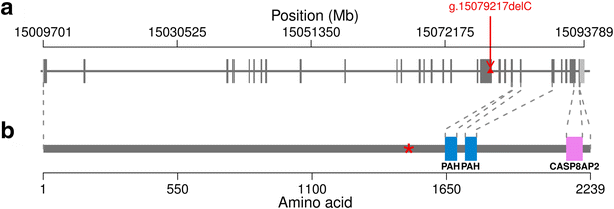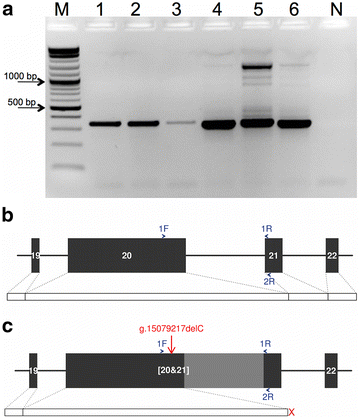A frameshift mutation in GON4L is associated with proportionate dwarfism in Fleckvieh cattle
- PMID: 27036302
- PMCID: PMC4818447
- DOI: 10.1186/s12711-016-0207-z
A frameshift mutation in GON4L is associated with proportionate dwarfism in Fleckvieh cattle
Abstract
Background: Low birth weight and postnatal growth restriction are the most evident symptoms of dwarfism. Accompanying skeletal aberrations may compromise the general condition and locomotion of affected individuals. Several paternal half-sibs with a low birth weight and a small size were born in 2013 in the Fleckvieh cattle population.
Results: Affected calves were strikingly underweight at birth in spite of a normal gestation length and had craniofacial abnormalities such as elongated narrow heads and brachygnathia inferior. In spite of a normal general condition, their growth remained restricted during rearing. We genotyped 27 affected and 10,454 unaffected animals at 44,672 single nucleotide polymorphisms and performed association tests followed by homozygosity mapping, which allowed us to map the locus responsible for growth failure to a 1.85-Mb segment on bovine chromosome 3. Analysis of whole-genome re-sequencing data from one affected and 289 unaffected animals revealed a 1-bp deletion (g.15079217delC, rs723240647) in the coding region of the GON4L gene that segregated with the dwarfism-associated haplotype. We showed that the deletion induces intron retention and premature termination of translation, which can lead to a severely truncated protein that lacks domains that are likely essential to normal protein function. The widespread use of an undetected carrier bull for artificial insemination has resulted in a tenfold increase in the frequency of the deleterious allele in the female population.
Conclusions: A frameshift mutation in GON4L is associated with autosomal recessive proportionate dwarfism in Fleckvieh cattle. The mutation has segregated in the population for more than 50 years without being recognized as a genetic disorder. However, the widespread use of an undetected carrier bull for artificial insemination caused a sudden accumulation of homozygous calves with dwarfism. Our findings provide the basis for genome-based mating strategies to avoid the inadvertent mating of carrier animals and thereby prevent the birth of homozygous calves with impaired growth.
Figures




Similar articles
-
Homozygous haplotype deficiency reveals deleterious mutations compromising reproductive and rearing success in cattle.BMC Genomics. 2015 Apr 18;16(1):312. doi: 10.1186/s12864-015-1483-7. BMC Genomics. 2015. PMID: 25927203 Free PMC article.
-
A nonsense mutation in PLD4 is associated with a zinc deficiency-like syndrome in Fleckvieh cattle.BMC Genomics. 2014 Jul 22;15(1):623. doi: 10.1186/1471-2164-15-623. BMC Genomics. 2014. PMID: 25052073 Free PMC article.
-
A frameshift mutation in MOCOS is associated with familial renal syndrome (xanthinuria) in Tyrolean Grey cattle.BMC Vet Res. 2016 Dec 5;12(1):276. doi: 10.1186/s12917-016-0904-4. BMC Vet Res. 2016. PMID: 27919260 Free PMC article.
-
Current insights into the molecular genetic basis of dwarfism in livestock.Vet J. 2017 Jun;224:64-75. doi: 10.1016/j.tvjl.2017.05.014. Epub 2017 Jun 2. Vet J. 2017. PMID: 28697878 Review.
-
Invited review: Bioinformatic methods to discover the likely causal variant of a new autosomal recessive genetic condition using genome-wide data.Animal. 2018 Nov;12(11):2221-2234. doi: 10.1017/S1751731118001970. Epub 2018 Aug 10. Animal. 2018. PMID: 30092853 Review.
Cited by
-
Assessing genomic diversity and signatures of selection in Original Braunvieh cattle using whole-genome sequencing data.BMC Genomics. 2020 Jan 8;21(1):27. doi: 10.1186/s12864-020-6446-y. BMC Genomics. 2020. PMID: 31914939 Free PMC article.
-
Reverse Genetic Screen for Deleterious Recessive Variants in the Local Simmental Cattle Population of Switzerland.Animals (Basel). 2021 Dec 12;11(12):3535. doi: 10.3390/ani11123535. Animals (Basel). 2021. PMID: 34944310 Free PMC article.
-
Biallelic loss-of-function variants in GON4L cause microcephaly and brain structure abnormalities.NPJ Genom Med. 2024 Nov 5;9(1):55. doi: 10.1038/s41525-024-00437-5. NPJ Genom Med. 2024. PMID: 39500882 Free PMC article.
-
Newly identified Gon4l/Udu-interacting proteins implicate novel functions.Sci Rep. 2020 Aug 26;10(1):14213. doi: 10.1038/s41598-020-70855-9. Sci Rep. 2020. PMID: 32848183 Free PMC article.
-
Identification and annotation of breed-specific single nucleotide polymorphisms in Bos taurus genomes.PLoS One. 2018 Jun 1;13(6):e0198419. doi: 10.1371/journal.pone.0198419. eCollection 2018. PLoS One. 2018. PMID: 29856873 Free PMC article.
References
-
- Utsunomiya YT, do Carmo AS, Carvalheiro R, Neves HH, Matos MC, Zavarez LB, et al. Genome-wide association study for birth weight in Nellore cattle points to previously described orthologous genes affecting human and bovine height. BMC Genet. 2013;14:52. doi: 10.1186/1471-2156-14-52. - DOI - PMC - PubMed
-
- Riley DG, Welsh TH, Gill CA, Hulsman LL, Herring AD, Riggs PK, et al. Whole genome association of SNP with newborn calf cannon bone length. Livest Sci. 2013;155:186–196. doi: 10.1016/j.livsci.2013.05.022. - DOI
Publication types
MeSH terms
Substances
LinkOut - more resources
Full Text Sources
Other Literature Sources
Medical
Miscellaneous

